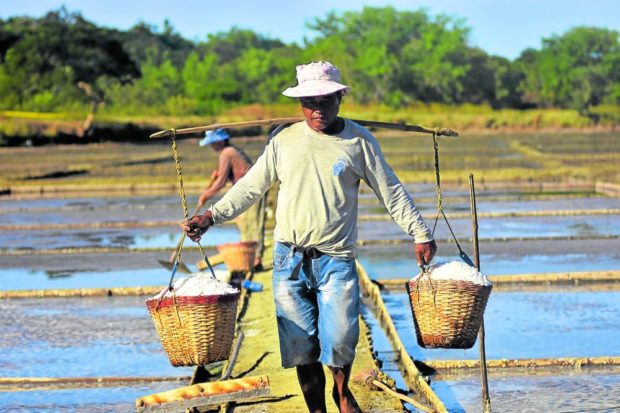
FILE PHOTO: A salt harvester in Barangay Telbang, Alaminos City in Pangasinan province. —WILLIE LOMIBAO
MANILA, Philippines — Despite being archipelagic with long shorelines, the Philippines may import 96 percent of its salt requirements by 2030 if the local industry is not revitalized.
Philippine Association of Salt Industry Networks (PhilASIN) president Gerard Khonghun issued this warning as the House committee on agriculture and food tackled on Tuesday House Bill No. 1976 authored by Kabayan Rep. Ron Salo.
If Salo’s bill is not enacted, the local industry may miss out on being self-sufficient and would just rely mainly on imported salt, according to Khonghun.
“The [forecast] annual importation by 2030 is about 1.3 million tons worth P6 billion. At that point, if we do nothing or if we don’t pass this measure, if the country does not gather around and have a strategy […] we will have about 96 percent imported salt,” said the PhilASIN leader.
“Salt self-sufficiency will contribute to the agro-industrial development of the Philippines. Salt is, therefore, a national food security issue — and without salt, we believe that the Philippines is vulnerable to a food supply chain crisis,” he added.
Khonghun also said the country presently consumes around 600,000 to 680,000 tons of salt annually. However, the passage of Republic Act No. 11504 or the Coconut Farmers and Industry Fund Act would create a demand of 300,000 tons as farmers use salt for fertilizers.
All in all, the country might need somewhere around 980,000 tons of salt per year, he noted.
“The Coconut Farmers and Industry Fund Act […] this one will create a demand for 300,000 tons of salt a year to fertilize the 300 million coconut trees. So that is a huge demand. That is worth P4 billion in local salt revenues,” Khonghun said.
“So the annual importation, looking at a two-year average, is about 628,000 worth $54 million in foreign exchange. That is the 92 percent of imported salt today. So looking at the long-term 10-year trend, we can see that the importation has been steadily increasing,” he added.
Khonghun blamed the country’s reliance on imported salt for the dwindling spaces for salt farming, noting that lands used in Cavite in the 1980s have been transformed into urban and residential areas by 2020.
READ: Salt industry revival plan to start with ‘profiling’ – DA
The same thing is now happening in Bulacan and other areas where salt farming used to flourish, he said.
“By 2020, a lot of areas are being converted. So a similar thing is now happening to Bulacan, there’s a lot of conversion of these areas into residential and commercial expansion: the Bulacan International Airport which will decongest the airports of Luzon are contributing to this conversion,” he said.
“As the areas were reducing due to this urbanization and conversion of land, there is an increasing salt consumption and salt demand,” he added.
The House committee on agriculture and food was discussing House Bill No. 1976, which contains provisions that would create an office focusing on salt production and mandate research on how salt farming can be reinvigorated.
Under Salo’s bill, an “Administration for Salt Industry Development, Revitalization and Optimization” will be tasked to ensure that the bill’s proposed objectives are attained.
Among others, the measure intends to identify new areas suitable for salt projects, support salt farms by constructing roads and providing equipment and compel local governments to support projects for the salt industry.
During the hearing, the committee withheld the bill’s approval, forming a technical working group instead of waiting for more inputs from other stakeholders and government offices.
Salt importation has been an issue frowned upon by lawmakers, believing that the country has the potential to be a leading salt producer in the region and worldwide. However, this August, Senate Majority Floor Leader Joel Villanueva said it is shameful for the country to import salt when it has more than 36,000 kilometers of shoreline.
READ: ‘Shameful’ for archipelagic PH to import salt, says Villanueva
In response, the Department of Agriculture assured the public that it is doing its best to boost salt production in the country.
READ: Department of Agriculture pushes boost to salt making